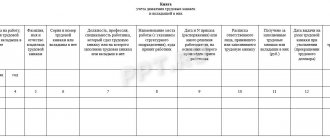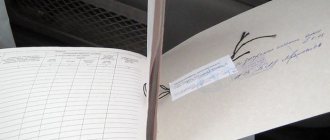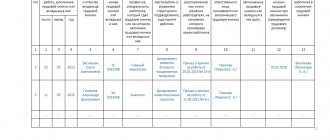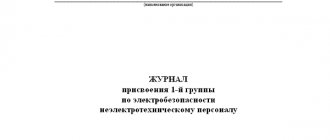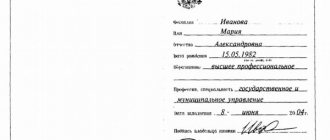Home / Labor Law / Personnel Management / Personnel Records
Back
Published: 08/05/2016
Reading time: 8 min
0
2645
Keeping records of work books at an enterprise or company is an important part of document flow and business management in general.
In our article, we will take a detailed look at current issues that interest our readers that are related to this topic: what legal acts regulate the keeping of records of work books, how the firmware of this type of work documents occurs, and we will also consider detailed instructions for flashing and sealing the documentation.
- Legislation
- Features of the firmware of the book of accounting for the movement of work books and inserts
- Firmware instructions
- Instructions for preparing a sticker sheet with a certification signature
- Sealing the accounting book Instructions for sealing the accounting book
Primary requirements
All requirements are based on the legislative regulatory framework, which is reflected in the Rules approved at the highest government level.
First of all, these include the Rules approved by the Government of the Russian Federation dated April 16, 2003, No. 225. This document almost completely regulates the established forms of organizing work with the journal, coordinating the requirements with the Decree of the Government of the Russian Federation dated March 1, 2008 No. 132, as well as - dated March 25, 2013, No. 257.
Certain provisions of the Rules are indicated in part 4, paragraph 40, which stipulates that according to the required regulations, the form of the magazine must comply with the standard established by the Ministry of Labor and Social Protection of the Russian Federation.
The book has an A-4 format, the volume in terms of the number of sheets should be designed for its maintenance for several years. In accordance with this, and also with the fact that the duration of its storage in the archive is many years, the cover must be thick.
Regulatory requirements do not oblige the employer to special conditions , on the basis of which the book form would have to be purchased from appropriate licensed sellers.
It has a regular standard cover and regular sheets, which should only have appropriate columns for making entries.
In accordance with this, other protective mechanisms are installed on the book, which the employer is obliged to create.
In accordance with paragraph 41, part 4 of the Rules:
- The book must be signed personally by the head of the enterprise.
- All sheets contained in it must be numbered manually by the personnel officer, authorized person or employer.
- The book must be bound and sealed.
Failure to comply with one of the listed requirements will result in a fine for the employer, and the journal keeping will be deemed improper.
Step-by-step instructions: how to flash a magazine?
First you need to bind the magazine if the binding is thin. The fact is that the magazine may not be finished yet, there will be free pages in it for taking notes, and the cover will be worn out.
It will be almost impossible to correct this violation, and during each inspection inspectors may point out the same defect to you and repeat their comment with the ensuing consequences.
After the magazine form is in order, fill out the title page according to all the rules and number the pages. Page numbering should be continuous - each subsequent page will have a number one greater than the previous page.
After numbering, check all serial numbers on the pages of the magazine. Their correctness is very important. After all, if at a certain stage a lack of pages or another error in numbering is discovered, the employer will have problems, at least in the form of fines.
Therefore, if you or the employer, when checking the form before signing, find an error in the numbering , the form will have to be replaced. For the same reasons, it is recommended to first fill out the title page and number it, and then stitch and seal the magazine, so as not to perform complex work in vain.
After preparing the magazine, we prepare materials and tools for the magazine stitching procedure. These include:
- awl;
- threads;
- some use a needle or crochet hook.
The quality of these items, in accordance with the purpose of use and the available options, must be considered separately.
Some experienced personnel officers use a particularly durable hole punch instead of an awl. If you manage to pierce the thickness of the magazine paper along with the cover, you are lucky.
In standard cases, an awl is used . It is a very strong knitting needle with a pointed end, like a needle on one side, and ends with a strong handle on the other side. By holding the handle tightly, you can use the tip to punch holes in the paper, even with a fairly large layer thickness.
The threads must be special and have enhanced strength and ductility. The ideal option would be a harsh or stitched thread LSh-210.
It is quite soft and durable, and in practice it has proven itself to be the most effective material for stitching documents.
In addition, many people use twine or regular cotton threads No. 10 . These are two extremes, which are followed by incompetent and uninformed personnel officers or persons who do not have the opportunity to purchase high-quality material for firmware.
Twine is good for stitching thick stacks of documents that are practically not used. But in the journal that you will use, the knots of the twine will “stand up like a stake,” which will create interference when making entries and, quite possibly, will lead to blots in the entries and to comments made in connection with this.
The threads will be too thin . They can tear themselves, as well as tear sheets of paper where they are held together with thread. Naturally, such a magazine will wear out before it is finished, which is also fraught with serious problems.
When using thread number ten, you will have to use a needle. In some cases, a crochet hook will help to thread the thread, with which the twisted thread can easily be hooked on the other side of the magazine by its edge, bent in the form of a loop.
You can use office glue or nail polish , lubricating the ends of the thread for greater rigidity. If you use varnish, cut it off immediately after finishing the stitching.
Once everything is prepared properly, you can flash the magazine. This is done on the left, in the margins of the magazine, as follows:
- Using an awl, 3 holes are punched at equal distances from each other, starting from the middle of the sheet.
There is no standard for the distance between the seams; it will be most convenient to step back 5-7 centimeters to the sides from the central hole. - The thread should be inserted from the back of the cover and pulled forward through the 2 outer holes.
- Gently pull the ends of the thread forward, align and connect them. Then, alternately or together, thread them through the central hole, pulling them from the front of the cover towards the back wall.
- If the thread is not strong, repeat the process several times, but do not pull the threads too tightly to avoid tearing the paper when using a journal. Each time, check that the thread is aligned and has the same shape as in the previous seam.
- The edges of the thread are tied along the back wall with a knot, making sure to capture the central thread in the knot being tied, grabbing it when tying.
After this procedure, do not even think about cutting off the ends of the thread that was used to stitch the magazine. They must remain relatively long (6 to 10 centimeters) for the subsequent procedure.
Materials for firmware
In order to lace a book, which is also a mandatory requirement, you need:
- An awl is a very strong knitting needle with a pointed end. Something like a thick needle without an eye. Due to the comfortable handle, it is possible to penetrate the thickness of the paper in almost one movement.
- Threads (twine) used to stitch the magazine. They must be strong, but at the same time flexible. Excellent solution LSh-20. This thread is strong and soft, and is easy to work with when stitching documents. Sometimes, due to lack of resources, they stitch the magazine with ordinary thread No. 10, but this is not very convenient and not very durable, so it is better to buy suitable ones once. In addition, such threads easily tear the paper, which is a violation in itself.
- Needle, crochet hook - for threading.
- Possibly a hole punch, but they need to penetrate the entire thickness of the magazine and the cover.
In order to make the tip of the thread more rigid, you can lubricate it with nail polish or office glue. After completing the process, be sure to cut off this section of the thread.
How to properly design a sheet for fastening threads
Remaining thread ends:
- carefully stretched to capacity;
- wrapped over the edge of the cover;
- glued from the inside.
You need to glue the end of the thread in a special way, using a small piece of paper, which must be prepared in advance as follows:
- Cut a square of approximately 8 cm from plain paper.
- Write on it “the magazine is stitched” and put the desired date using Arabic numerals.
- Have the head of the organization sign this signature.
- Glue the piece of paper to the inside of the back cover by threading the thread through it.
- Apply the organization's seal.
A pasted piece of paper is the first and most basic step in protecting a bound magazine from outside interference. It connects 3 fragments:
- cover;
- filling thread;
- seal.
The artificially created unity will be destroyed almost immediately upon intervention, which will make it possible to detect the problem and take timely measures to correct the situation.
The pasted sheet plays an important role in the further process, during sealing.
Instructions for preparing a sticker sheet with a certification signature
We remind you that such a sheet is glued to the threads on the inside to prevent possible interference with the book’s firmware itself, which undoubtedly increases the reliability of document storage.
- The accepted size of the sticker sheet is 4 by 3 centimeters; it should cover both the knot itself and most of the threads.
- The seal of the responsible employee of the personnel department is applied to the sticker sheet, and it is also customary to put a signature. It is noteworthy that the signet itself must capture not only the sticker sheet, but also part of the book, in case of arbitrary interference in the firmware.
- The certification must indicate the number of pages in the book (both in numbers and in words).
Sealing rules and choice of seal
The most reliable protection will be a seal, as specified in Rules No. 225, which stipulate that the journal must be sealed with a wax seal or sealed.
What will you need?
For sealing, you will need a wax seal or seal, which will completely block the possibility of interference in the journal entries and will confirm the integrity of the records or indicate a violation. That is, the seal is protection against unauthorized intervention.
Fillings are divided into two types:
- power;
- control.
They have different purposes, approved by GOST 31282 -2004. Power seals include lead seals, which require greater force to remove. Lead seals are not used on the documents in question.
But if desired or for certain reasons, they can be used. Today, beautiful small lead, metal and non-metallic seals are made, suitable for the accounting book (see here for information about the receipt and expenditure book).
In this case, a control seal is often used , which is an analogue of a wax seal or a lead seal, but does not contain a resistance force, resembling it only in shape. It serves only to detect tampering with log entries, indicating a violation of integrity.
After sealing or sealing, it will be impossible to replace the sheet in the journal when correcting the entry. This will not be possible with a seal attached to the tip of the thread or fixing the thread in one position.
GOST 31282 -2004 presents the widest range of possible seals for use. However, in this case, those that are suitable for use in office work can be used.
Power seals will not play a specific role here; the most acceptable option would be control license plates. The most important thing in sealing or sealing is the establishment of an identifier, a unique seal number.
Criteria established by law
The provisions of GOST 31282 -2004 determine the criteria for seals established by law. These include:
- Availability of identification number.
- Disposable nature of use, impossibility of reproduction.
- Protection against possible access by forceful retention and (or) indication.
Criterias of choice
The range of production of fillings according to GOST today can be the widest, with a variety of shapes and colors. You can choose a worthy option based on additional criteria that are based on the preferences of a particular organization. It is possible to make a sealing device:
- With the organization's logo.
- In the form of a metal seal.
- In the form of a metal rod with a unique number depicted on it.
- With a color indicator that will immediately indicate an attempt to break the seal.
- With elements of electronic memory.
Classic fillings are:
- lead products;
- made of plastic;
- metal controller MK-1;
- MK metal clips.
All of them have excellent protective properties, which is the basis and purpose of the sealing process. A wide selection includes different ways of installing fillings. However, all methods have common functions, which allows you to install it yourself.
Features of the firmware of the book of accounting for the movement of work books and inserts
This accounting book records data related to the movement of work books in the organization: registration, sending or receiving.
Such a record book is kept in the personnel department of the enterprise or src=»https://zakonguru.com/wp-content/uploads/2016/06/Depositphotos_106979008_original.jpg» class=»aligncenter» width=»360″ height=»540″[ /img]
The HR employee is in charge of filling out and installing the firmware. To properly flash this book, you need to know what it is and have basic knowledge about firmware, which you will get by reading the instructions below.
This accounting book contains the following documents:
- Work books. Both issued in a given enterprise or company, and received for the first time during employment in the same organization.
- Inserts that are part of the work book and were received while working in the organization.
Actually, documentation firmware is one of the main ways to organize documentation in an organization, designed to reduce the total volume of documents, as well as simplify their search and increase the reliability of storage.
The main reason for flashing is to protect documentation from possible removal or replacement of certain sheets . It is thanks to firmware and sealing, which we will discuss later, that the documentation is protected from arbitrary interference by other people.
State standards do not regulate firmware down to the smallest detail, so a standard established procedure is used, taking into account the norms and rules of the law.
Step-by-step instructions: how to seal a magazine?
To seal or seal the magazine you will need:
- impression and sealing wax;
- film number seal;
- filling made of a different material.
For sealing, an impression is required, which is quite difficult to produce and requires certain costs and sealing wax. If you want to use this method of protection, which has been used for a long time, then you need:
- Melt a small amount of sealing wax.
- Carefully pour hot sealing wax onto the inside of the magazine cover in the place where the thread is secured to the sheet that was used to glue it to the cover.
- Place an impression on the wax that has not cooled down.
- Allow to cool, after which you can use.
It must be taken into account that a typo can be made inaccurately due to lack of experience and dexterity . Therefore, first try to practice on a blank sheet of paper. In addition, the wax seal may crumble before you finish using the magazine, which will lead to its unsuitable appearance.
Modern fillings are highly durable products, the fixation of which does not require much effort from you. For people who frequently perform fillings, it is advisable to have a sealer that can be used to place any fillings.
To do this, you need to take this tool, which resembles forceps, hold the ends of two threads and the material included with the kit in it simultaneously, and secure the seal. This device is easy to use.
The most budget options for fillings that can be used instead of wax seals:
- Sticker seals that you just need to stick on according to the instructions and smooth out. When you try to open it, an inscription appears on it indicating the fact of intervention.
- Warranty labels that can be simply affixed in accordance with the instructions. If opened unauthorized, they almost completely crumble.
- The adhesive seal is simply glued using the adhesive tape technology. When you try to open it, the top layer becomes unusable.
If you like to make various exclusive things with your own hands, or you can simply make a filling for free from scrap material, attach it to the tip of two threads folded together. Enter the number.
Upon completion of the sealing, a commission of at least three people must be assembled to draw up a report. Having drawn up the act, put it in the folder with local nomenclature documents.
the seal number on the inside of the magazine , have the employer sign and seal it.
